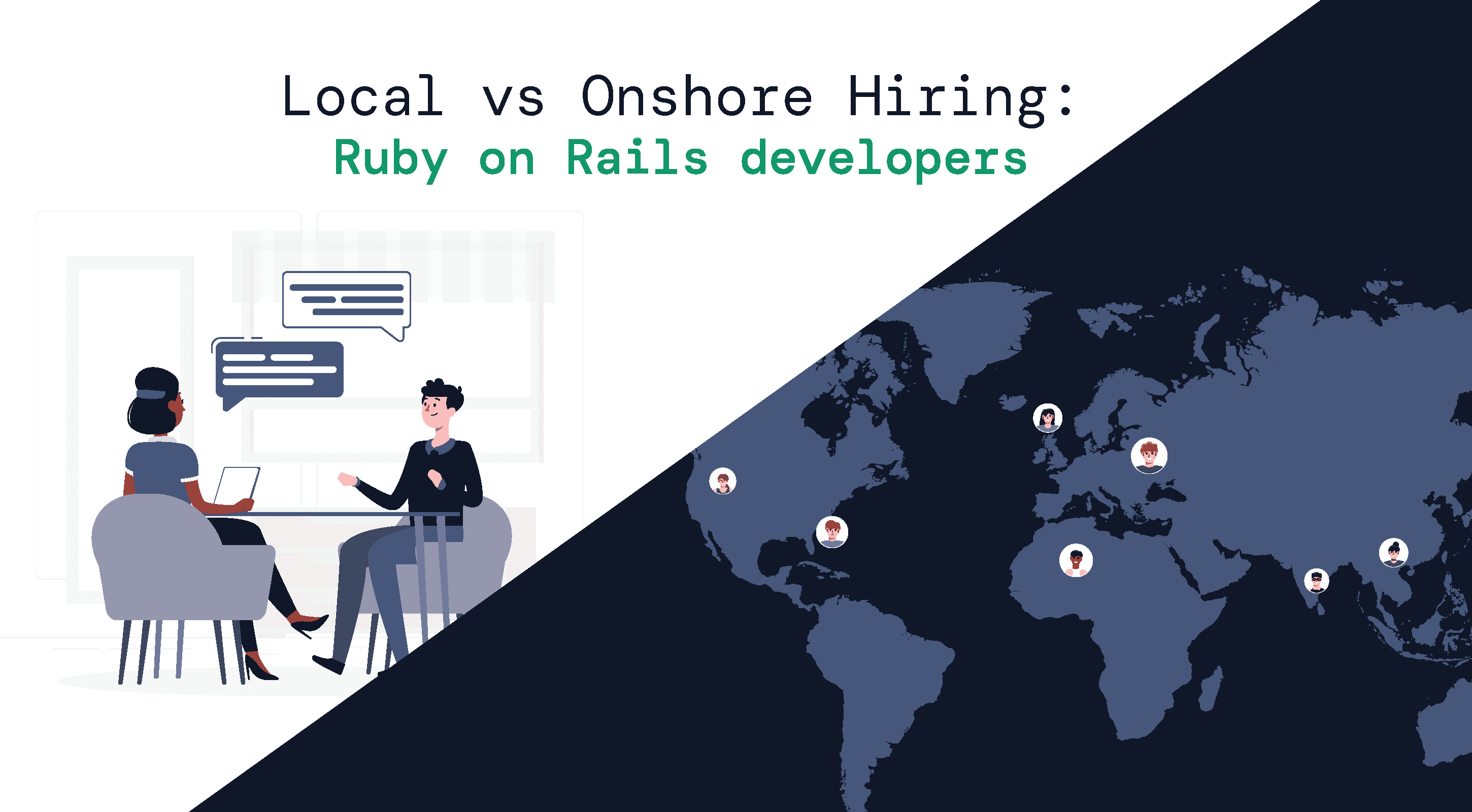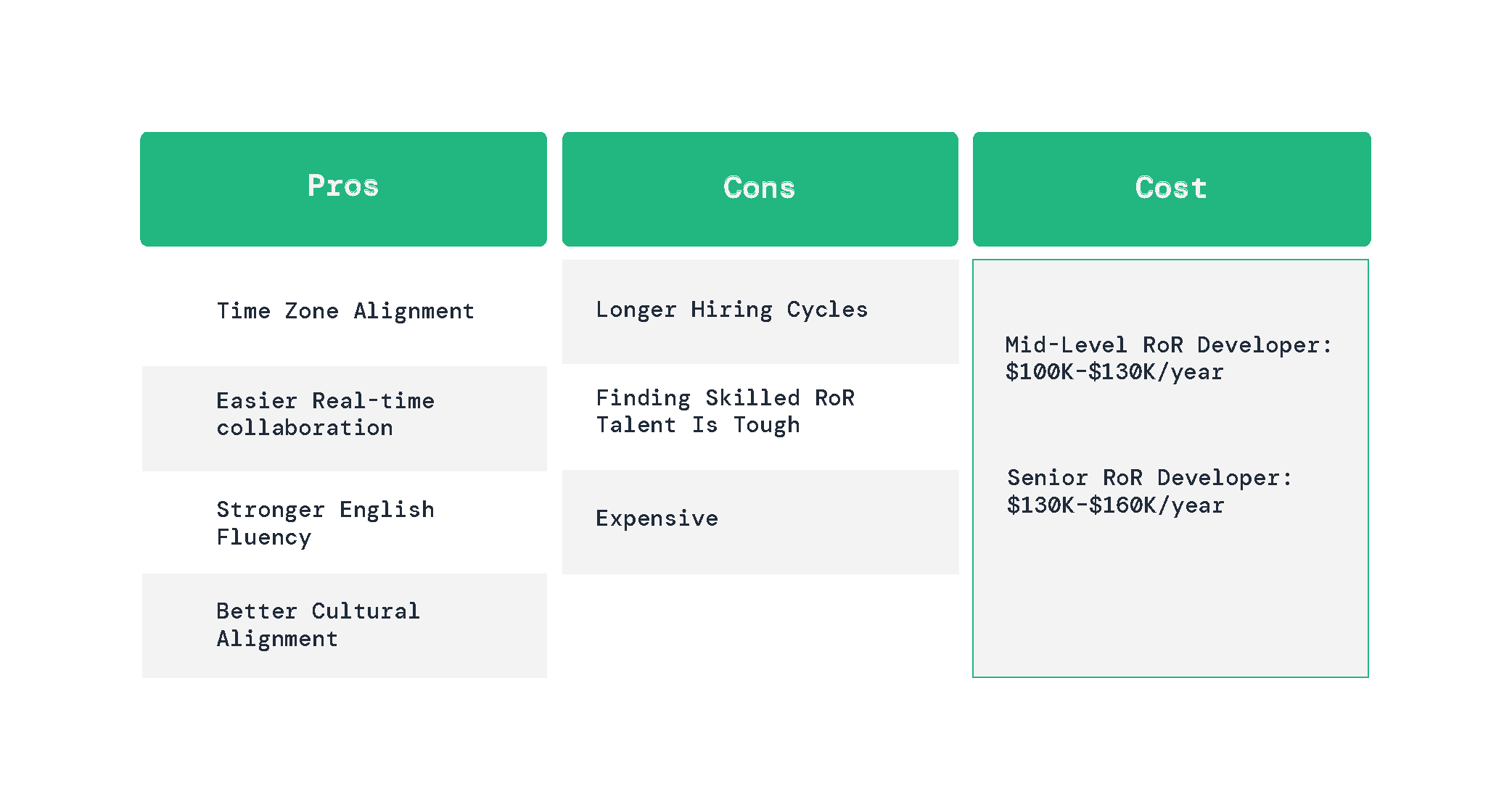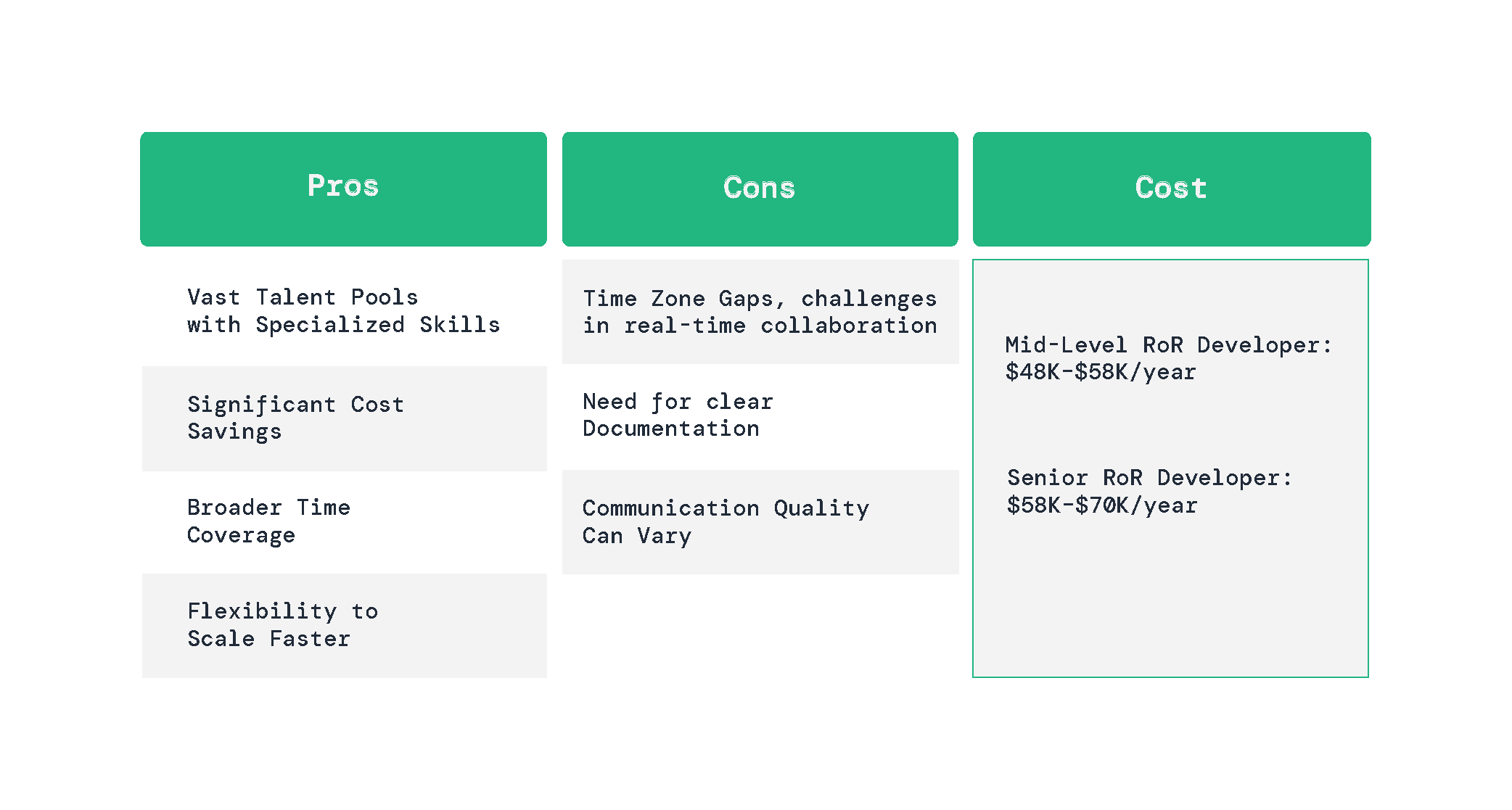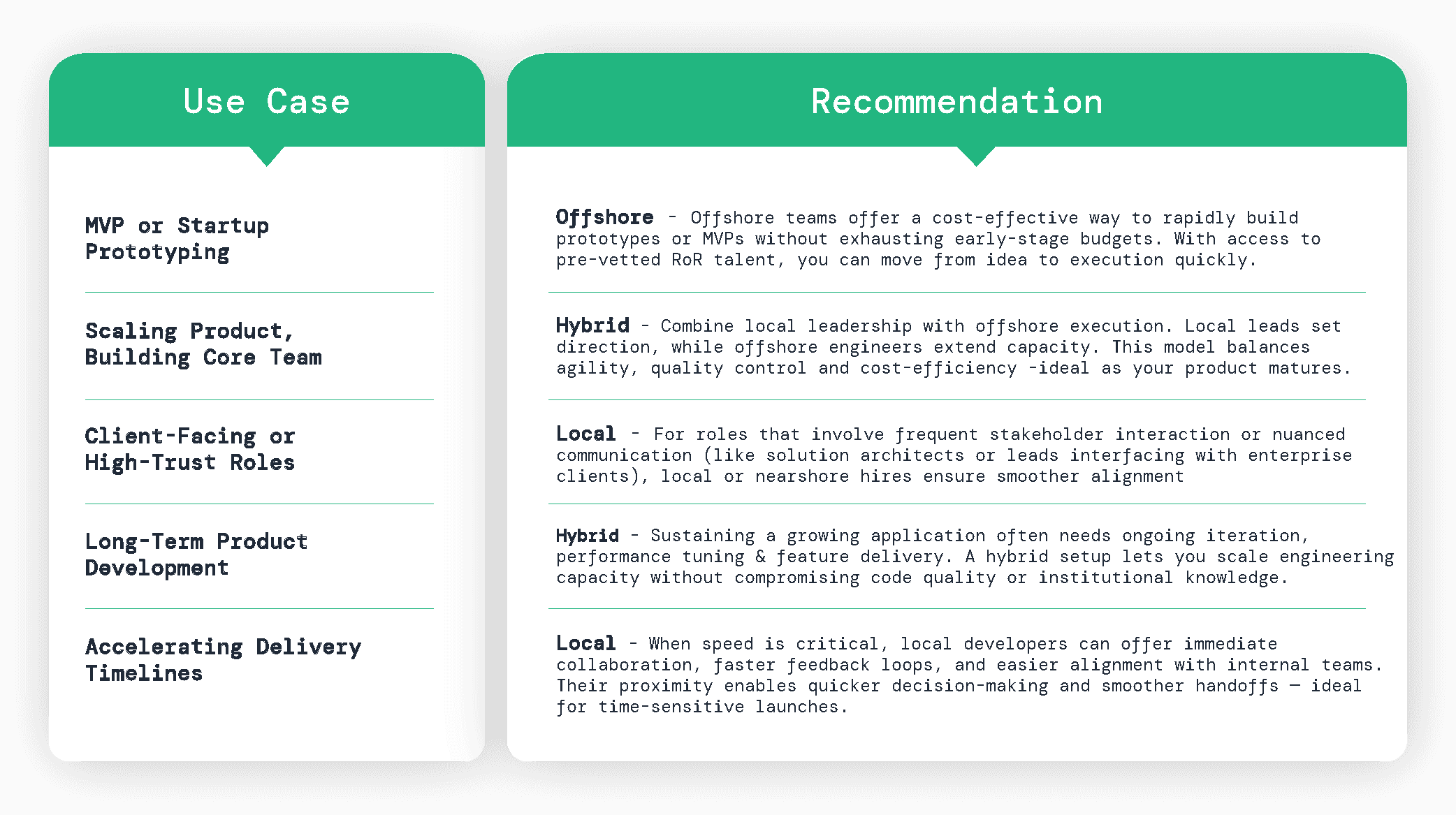Local VS Offshore Hiring for Ruby on Rails Developers: What Companies Need to Know?
Explore the pros, cons, and cost implications of hiring RoR developers from local & onshore organizations and make a well-informed hiring decision.

Pichandal
Technical Content Writer

Every business has unique needs when it comes to building software. And in today’s globally connected tech ecosystem, the decisions you make around hiring can shape everything from delivery timelines to long-term product stability.
According to Grand View Research, the global IT services outsourcing market was valued at $744.6 billion in 2024, and it's projected to grow at a CAGR of 8.6% through 2030. That growth reflects a broader reality: the tech talent market is more interconnected and competitive than ever.
When businesses look to delegate software development, they usually face two options: hire locally or go offshore. The local vs offshore talent debate has become a central consideration for companies looking to build scalable, resilient teams.
For technical roles like Ruby on Rails developers, this choice goes far beyond cost. It impacts collaboration, velocity, product quality, and even how your team operates day to day. Whether you're considering expanding in-house capacity or working with offshore Ruby on Rails developers, each approach comes with clear advantages and trade-offs.
In this blog, we’ll break down the real pros, cons, and cost implications of each path and explore when a hybrid model makes the most sense. Whether you’re a startup founder, a scaling tech company, or a product owner, this article will help you make a hiring decision that fits both your build goals and your budget.

Local Hiring of RoR Developers: Pros, Cons, and Costs
Hiring rails developers locally is often seen as the safe or default route for growing tech teams. It’s a familiar model with clear communication channels, timezone overlap, and shared cultural context. But when you’re building a Ruby on Rails product, especially in a fast-moving business environment, the nuances go deeper than proximity alone.
Pros of Hiring Locally
Time Zone Alignment
When teams operate within overlapping working hours, feedback loops are shorter, and context stays fresh. Product managers, designers, and developers can quickly align on edge cases, clarify requirements, and address technical blockers. For teams working on early-stage products or rapidly shipping features, that immediacy can reduce rework and keep momentum high.
Cultural Alignment
Hiring locally often means developers are aligned not just with your company’s values and workflows, but also with the broader cultural context, including shared norms, work ethics, and communication expectations. This alignment can lead to faster team cohesion, smoother collaboration, and a more intuitive understanding of business goals. It also helps teams navigate roadblocks with greater trust and innovate together .
Stronger English Fluency
Hiring within the same region often means fewer language barriers, shared communication norms, and smoother day-to-day interactions. This is especially valuable in roles that involve direct stakeholder interaction, where clarity and quick decisions matter most. It helps teams avoid missteps that can stem from missed context or communication gaps.
High Availability for Real-Time Collaboration
Having developers in the same time zone allows for quick access to support, enabling faster decision-making and real-time troubleshooting. For urgent fixes or ongoing maintenance of rails application, local talent will be helpful to ensure that issues are addressed promptly, reducing downtime and keeping the product development process on track.
The Challenges Behind the Sticker Price
Longer Hiring Cycles
Finding the right Rails developer locally can take 3��–4+ weeks, especially for mid- to senior-level engineers who are familiar with Rails conventions, background jobs, complex database optimizations and performance tuning. In addition to the extended search time, the competitive job market for top-tier talent means many candidates are already in high demand.
Lastly, the interview and vetting process for specialized skills like these can be lengthy, further delaying the hiring decision.
Finding Skilled RoR Talent Is Tough — and Expensive
While general developer availability has grown, sourcing Ruby on Rails engineers with hands-on experience in API integrations, background job queues, and security best practices remains challenging.
Many qualified candidates are already embedded in long-term roles and often command top-of-market salaries, along with competitive perks and flexible work expectations. This creates a narrow hiring window, especially if you're targeting local talent with deep Rails expertise.
What It Costs
Hiring a U.S.-based Ruby on Rails (RoR) developer through a local firm typically comes at a premium cost, even without full-time employment overheads.
-
Mid-Level RoR Developer: $100K–$130K/year
-
Senior RoR Developer: $130K–$160K/year
While you’re not paying payroll taxes or bonuses, you're still investing heavily due to higher hourly rates. This is a very reason why many companies explore offshore alternatives.

Hiring Offshore RoR Developers: Pros, Cons, and Costs
When local talent pools don’t meet your needs or your budget, offshore hiring can be a game-changer. Tapping into global markets opens access to specialized skills and significantly lowers hiring costs. However, like any strategy, offshore hiring comes with its own set of challenges. That’s a reason why, choosing the right Ruby on Rails developers or development team requires thoughtful evaluation.
Pros of Offshore Hiring
Access to Broader, Specialized Talent Pools
Offshore regions like India, Eastern Europe, and LATAM have cultivated deep technical expertise in Ruby on Rails over the past decade. Many developers in these markets bring hands-on experience in building scalable applications, API-driven architectures. optimizing performance and managing complex back-end systems. For companies facing niche requirements, tapping into global talent often uncovers profiles that are hard to find locally.
Significant Cost Savings
The cost difference isn’t just marginal, it’s substantial. Offshore developers with mid-to-senior RoR expertise can often be hired at substantial lower rates than their U.S. counterparts. Businesses can redirect these cost savings toward other high-impact priorities such as enhancing product features, strengthening QA processes, or accelerating market growth.
One of our clients, an enterprise software licensing solutions provider, initially outsourced four Ruby on Rails developers through us to support their in-house team. Over five years, the offshore team grew to 10 members. Eventually, they began replacing some of their internal team with high-skilled RoR developers from RailsFactory — recognizing the value in both quality and cost-efficiency.
“The right RoR partner = technical excellence, scalable talent, and long-term cost efficiency.”
Broader Time Coverage
While time zone gaps can be a challenge, they can also be a benefit. Offshore teams working ahead of your local timezone can push code or resolve tickets by the time your internal team logs on, enabling around-the-clock productivity.
Flexibility to Scale Faster
Hiring offshore often enables quicker ramp-up. For instance, at RailsFactory, a company with over 18 years of experience in the Ruby on Rails space, we maintain a pre-vetted talent pool of 350+ RoR experts. This allows you to hire or scale your team in just a week. With such expertise readily available, you can confidently tackle short-term spikes, MVP builds, or parallel development streams.
Experienced with Remote Collaboration
Many offshore developers are already accustomed to distributed work. From async updates to detailed documentation and collaborative tooling, they’re typically fluent in remote-first processes, reducing onboarding friction.
The Challenges Behind the Sticker Price
Time Zone Gaps
While working with offshore teams can significantly reduce costs, time zone differences often create challenges in real-time collaboration. This means decisions may take longer, and issues that arise during the day may need to wait for the next team's working hours to be addressed. With proper planning and asynchronous workflows, businesses must ensure smooth progress.
Given the importance of timezone overlap, at RailsFactory, we ensure a smooth 2–3 hour overlap with your local team, ensuring consistent communication and collaboration across time zones.
Need for clear Documentation
To mitigate the challenges of working across time zones, clear documentation and well-defined communication protocols are a must. Teams will need to rely heavily on written records, project management tools, and detailed specifications to avoid miscommunication and ensure everyone stays aligned.
Communication Quality Can Vary
Not all offshore teams have the same level of fluency or familiarity with the project’s technical requirements. The right partner is key. By choosing an experienced organization for hiring skilled RoR developers or teams, you can ensure they possess strong communication skills and are able to understand and articulate complex technical concepts clearly.
What It Costs
Offshore hiring can provide substantial savings, but it's crucial to understand the breakdown by experience level for more accurate budgeting.
India:
-
Mid-Level RoR Developer: $48K–$58K/year
-
Senior RoR Developer: $58K–$70K/year
Offshore hiring in market like India provides access to skilled Ruby on Rails developers at a lower cost than local options. These cost savings make it easier for businesses to scale their teams efficiently while maintaining high-quality output for ongoing development needs.
That said, it’s important not to chase the lowest possible rates. Extremely low-cost options often lead to compromises in code quality, reliability, and long-term maintainability, making it crucial to strike the right balance between cost and competence.

Use Cases: When to Choose Local, Offshore, or a Hybrid Model
After nearly two decades of supporting Rails development across startups and enterprise-grade products, we’ve seen that the right hiring model depends on where your product is — and where it's going. Here's a breakdown of what we at railsfactory often recommend:

From early builds to long-term scale-ups, we’ve seen companies succeed with every model, but the key is intentionality. Offshore hiring, when done right, doesn’t just lower cost; it enhances flexibility, speeds up delivery, and helps you stay ahead in fast-moving markets.
Final Words on Hiring Local vs. Offshore Talent
In simple words, both local and offshore hiring of RoR developers come with their own advantages and trade-offs. There's no universal answer, what works for one team might not suit another. Success depends on how well your hiring strategy supports your organization's objectives, workflows, and team capabilities.
That said, companies that take time to assess the full picture, from potential risks and use cases to communication workflows and team protocols, often find offshore to be a highly cost-effective and scalable option. With the right partner and structure in place, offshore teams can offer the agility, expertise, and reliability that modern Rails projects demand.
With over 18 years in the Ruby on Rails ecosystem and having delivered 850+ applications across 12+ industries with skilled RoR engineers, RailsFactory can help you scale with confidence. And we were recently recognized as a top Ruby on Rails development company on Clutch, a recognition that reflects the trust our clients place in us.
If you're looking to hire offshore Ruby on Rails developers from the right partner for your ongoing projects, look no further. Contact us today to discuss any of your Ruby on Rails needs, we are here to help you!



